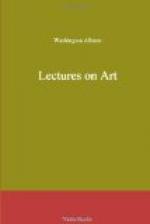It must be very obvious, that, in classing together any of the productions of the artists above named, it cannot be intended to reduce them to a level; such an attempt (did our argument require it) must instantly revolt the common sense and feeling of every one at all acquainted with Art. And therefore, perhaps, it may be thought that their striking difference, both in kind and degree, might justly call for some further division. But admitting, as all must, a wide, nay, almost impassable, interval between the familiar subjects of the lower Dutch and Flemish painters, and the higher intellectual works of the great Italian masters, we see no reason why they may not be left to draw their own line of demarcation as to their respective provinces, even as is every day done by actual objects; which are all equally natural, though widely differenced as well in kind as in quality. It is no degradation to the greatest genius to say of him and of the most unlettered boor, that they are both men.
Besides, as a more minute division would be wholly irrelevant to the present purpose, we shall defer the examination of their individual differences to another occasion. In order, however, more distinctly to exhibit their common ground of Invention, we will briefly examine a picture by Ostade, and then compare it with one by Raffaelle, than whom no two artists could well be imagined having less in common.
The interior of a Dutch cottage forms the scene of Ostade’s work, presenting something between a kitchen and a stable. Its principal object is the carcass of a hog, newly washed and hung up to dry; subordinate to which is a woman nursing an infant; the accessories, various garments, pots, kettles, and other culinary utensils.
The bare enumeration of these coarse materials would naturally predispose the mind of one, unacquainted with the Dutch school, to expect any thing but pleasure; indifference, not to say disgust, would seem to be the only possible impression from a picture composed of such ingredients. And such, indeed, would be their effect under the hand of any but a real Artist. Let us look into the picture and follow Ostade’s mind, as it leaves its impress on the several objects. Observe how he spreads his principal light, from the suspended carcass to the surrounding objects, moulding it, so to speak, into agreeable shapes, here by extending it to a bit of drapery, there to an earthen pot; then connecting it, by the flash from a brass kettle, with his second light, the woman and child; and again turning the eye into the dark recesses through a labyrinth of broken chairs, old baskets, roosting fowls, and bits of straw, till a glimpse of sunshine, from a half-open window, gleams on the eye, as it were, like an echo, and sending it back to the principal object, which now seems to act on the mind as the luminous source of all these diverging lights. But the magical whole is not yet completed; the mystery of color has been called




